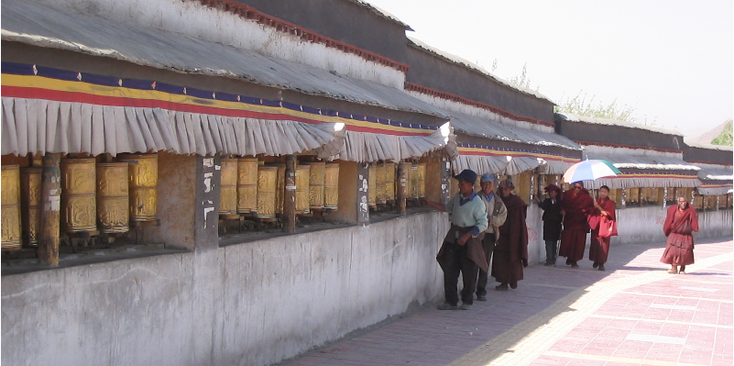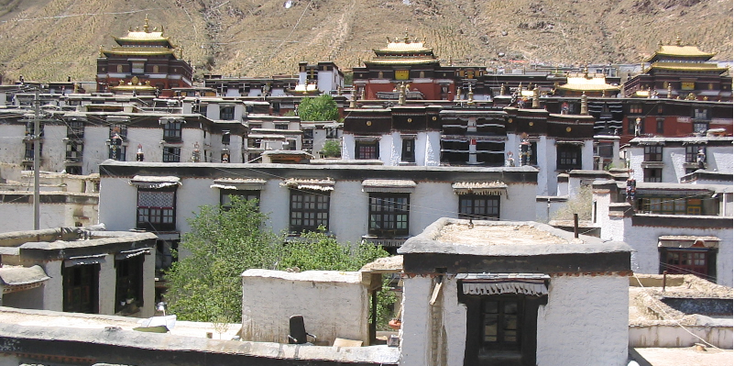Shigatse (Tibet)
Places of Interest - China


introduction
Shigatse is the second city in the Tibet Autonomous Region and has a much more Tibetan population then for example capital Lhasa. It has a long "militant" history with the capital Lhasa in terms of administrative control and influence. In historical Tibet, Shigatse was the capital of the Tsang province. From the fort in the city the kings and later governors ruled the region. The city lies at the confluence of the rivers Yarlung Tsangpo and Nyangchu at an altitude of 3840 meters. This makes Shigatse the highest city in Tibet and the People's Republic of China.
The annual average of the temperature is 6°C. The city has a relaxed atmosphere and has as its biggest tourist attraction the beautiful "Tashilhunpo" temple within the city limits. Previously, this was the seat of the pänchen lama, one of the most important authorities in Tibetan Buddhism. The pänchen lamas stayed in this monastery since 1446.
highlights

Tashilhunpo monastery:
The Tashilhunpo monastery was built in Shigatse in 1447 and is one of the 6 large Gelug institutions. The monastery is located on a hill in the city and the name means in Tibetan literally "all happiness and prosperity are collected here". The monastery is the traditional seat of the pänchen lama, the second tulku line within the gelug school of Tibetan Buddhism.
It is an important destination for pilgrims in Tibet. The monastery was originally built by Gendün Drub, the first Dalai Lama and financed by the local nobility. Later the monastery was greatly expanded by Lobsang Chökyi Gyaltsen, the 4th pänchen lama. Since then it has become the seat for the pänchen lamas. Gyancain Norbu, who according to the Chinese government is the 11th pänchen lama, lives here. Once there lived some 6000 monks - now only 600.
Besides the gigantic large statue of Buddha (almost 27 meters high) in the temple of Maitreya, the temple is also famous for its large Hall which is the tomb of the 4th Panchen Lama retains. This would contain about 85kg of gold and a multitude of jewels. The monastery can be reached via three steep stairs. The left staircase is for entering the temple, the middle staircase for the pänchen lama and dalai lama and the right staircase is for leaving the temple. Tashilhunpo has been on the list of cultural heritage sites in the Tibet Autonomous Region since 1961.
Other attractions:
- The Shigatse fort (north of the old town).

history

The present city of Shigatse developed at the foot of the old Samdrubtse fortress which was rebuilt in 1363 and to which the city was initially named. Until the 20th century, the city was often called Shigatse Dzong. Until the mid-17th century, Shigatse was the seat of the kings of Tsang, who ruled over large parts of Tibet including Lhasa over a longer period of time.
When in the first half of the 17th century, with the help of the Mongolians from Amdo, the gelug-orde managed to reduce that dominion, the fifth Dalai Lama became the ruler of Tibet in 1642. The Dalai Lama then had the Potala built, with the Samdrubtse from Shigatse as an example. In beauty and size, however, the Potala clearly outperforms it. In 1788 and 1791, the city and the monastery were attacked and pillaged by gurkhas wandering from Nepal.
These two invasions were reason for the Chinese emperor Qianlong to intervene militarily and to expand control mechanisms over Tibet. In 1950 Samgrubtse was destroyed. Between 2005 and 2007 the fortress with money from Shanghai was reconstructed. Old photos were used as a basis for reconstruction, although the walls of the current version are built of cement or concrete, which are adorned only with natural stone.

tips & advice (2004)

-
Name: Qomolongma Friendship hotel
Address: Zhufeng Youyi Binguin
Price: 75Y (dormitory)
Phone nr. : 8821929
Content:
This hostel is located about 500 meters from the Tashilhunpo monastery and on the other side where most of the restaurants are located. It is on a relatively busy road and has different types of rooms (including doubles and triples).
The rooms are usually rented to tour groups coming from Nepal with puclic transport with mainly Western tourists. The dormitories are very basic with "squat" toilets. There is also a reasonable restaurant. You pay extra for the showers.
see also:
LANDEN:
EUROPA:
Albanië * België * Bosnië-Herzegovina * Bulgarije * Denemarken * Duitsland * Engeland * Estland * Finland * Frankrijk * Griekenland * Hongarije * (Noord) Ierland * Italië * Kosovo * Kroatië * Letland * Litouwen * Luxemburg * Macedonië * Malta * Montenegro * NEDERLAND * Oekraïne * Oostenrijk * Polen * Portugal * Roemenië * Rusland * Schotland * Servië * Slovenië * Slowakije * Spanje * Tsjechië * Turkije * Zweden
NOORD EN CENTRAAL-AMERIKA:
Chili * Costa Rica * Cuba * Guatemala * Mexico * Nicaragua * Panama * Verenigde Staten
ZUID-AMERIKA:
Argentinië * Bolivia * Brazilië * Colombia * Ecuador * Peru
AFRIKA:
Botswana * Burkina Faso * Egypte * Ethiopië * Ghana * Kenia * Mali * Marokko * Namibië * Oeganda * Senegal * Tanzania * Tunesië * Zuid-Afrika
MIDDEN-OOSTEN:
Iran * Israël * Jordanië * V.A.E.
AZIE:
Armenië * Cambodja * China * Filipijnen * Georgië * India * Indonesië * Japan * Kirgizië * Laos * Maleisië * Mongolië * Myanmar * Nepal * Oezbekistan * Singapore * Sri Lanka * Thailand * Vietnam
OCEANIE:
Voor meer reisfoto's kijk op www.instagram.com/cheapskatetravel.nl:
© Cheapskatetravel.nl; 2018 (all rights reserved)


